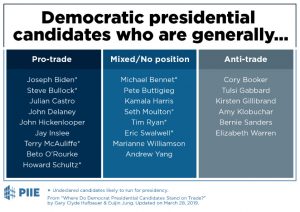The Nation’s Editor Katrina vanden Heuval has the progressive response to Trump’s bellowing about “the best economy ever” under his Administration: “It’s true that wages have begun to rise a bit, with demand for workers and minimum-wage hikes in states and localities finally giving a boost to those on the bottom. But the average weekly pay has grown less than 1 percent per year for the decade. Low-wage workers’ hourly pay in 2017 barely surpassed what they earned in 1979, while that of high-wage workers has increased nearly 50 percent. Inequality is at extremes not seen since 1928. Workers are still not capturing a fair share of the increased productivity that they help to create…And while incomes have stagnated, key costs have soared. Health care remains remarkably expensive; millions go without insurance or are underinsured. Gallup reports that since Trump took office, the number of Americans without health insurance has increased by a stunning 7 million. Female, younger and lower-income workers have seen a greater decline than those who are male, older and/or wealthier. Life expectancy has declined for the third year in a row. The lack of health care explains part of that. The savage opioid epidemic—a disease of despair—accounts for another chunk.”
Osita Nwanevu explains how “Progressive Activists Are Pushing the Democratic Field on Political Reforms” at The New Yorker: “To the extent that Democrats have engaged with the appetite for political reforms, they have done so by endorsing ideas that the next Democratic President will probably be unable to see through, like the elimination of the Electoral College, or ideas that, while achievable and well grounded, like automatic voter registration or campaign-finance reform, do not resolve the main challenges to Democratic policymaking. The primary obstacle to the next Democratic President’s agenda will be the anti-majoritarian institutions and norms that shape federal policymaking. These could conceivably be altered by a Democratic President and Congress, but in ways, such as eliminating the filibuster and expanding the Supreme Court, that the Democratic Presidential candidates have mostly refused to explicitly endorse. Progressive activists have yet to truly penalize the 2020 contenders for their reticence. But, as the promises made by the candidates grow bolder by the week, we can expect more questions, like the toughest ones posed Monday, about how, exactly, they intend to keep them.”
Sure, there are lots of people who are happy with their health insurance, as well as millions more who are not. But you don’t have to look very far for the horror stories, nor for statistics that show how poorly the health insurance industry serves the public overall, as Roqayah Chamseddine documents in his article, “A Healthcare Industry Built on Premature Death: On the cruelty of private healthcare corporations.” As Chamseddine writes, “The industry is an architecture of misery, extracting profits from suffering. According to a report published in 2017 by The Doctor-Patient Rights Project, insurance companies “denied treatment coverage to one-in-four (24 percent) patients with a chronic or persistent illness or condition; 41 percent of the patients denied coverage were denied once, while 59 percent were denied multiple times.” Thirty-four percent of patients who had been denied coverage were forced to put off treatment, despite having a chronic illness. An astounding 70 percent of treatments for a chronic illness denied by insurers were for conditions referred to as “serious.” The grim reaper disguises himself in many forms, in this case that of an insurance agent.”
At shareblue.com, Oliver Willis has some talking points for Democrats regarding Republicans and veterans. As Willis reports, “Acting Office of Management and Budget (OMB) Director Russell Vought testified before the House Budget Committee on Tuesday…In his 2019 budget, Trump has proposed rounding down the cost-of-living adjustments given to veterans. Military Times notes that the idea “has been decried by veterans groups in the past as unfairly using their earned benefits to balance the budget.”…Vought said, “We don’t think [the cuts] will have any adverse impact” when asked about the attack on veterans by Rep. Seth Moulton (D-MA)…”No adverse impact? No adverse impact to decreased cost of living adjustments?” Moulton asked incredulously…”That’s correct,” Vought replied. “I think you should speak to some veterans, Mr. Vought,” the congressman replied, ending the exchange…The cold dismissal of veterans’ concerns is the latest in a long line of slights and attacks on the military from Trump. He largely views the armed services as a useful backdrop for his presidency, via venues like parades, rather than as an institution to be supported and respected…In the same budget document, Trump fraudulently takes credit for the “largest” increase in military pay in a decade, but the military received larger increases twice under Obama.”
Eric Levitz has some bad news for Dems at New York Magazine’s Intelligencer: “In Wisconsin’s gubernatorial race last year, Democrat Tony Evers defeated Scott Walker by one percent statewide — but won a majority of votes in only36 of the state’s 99 Assembly districts. That same night, Democratic candidates won 53 percent of all ballots cast for the state Assembly, even as Republicans won a 27-seat majority in that body…In other words: The 2018 midterms confirmed that the GOP has gerrymandered Wisconsin’s electoral maps so aggressively, it will be essentially impossible for the Democratic Party to gain control of that (purple) state’s legislature until its maps are redrawn…This point was not lost on the Wisconsin GOP. Immediately following Evers’s victory, Republicans convened a special legislative session to transfer powers from the popularly elected branch of government that Democrats had just won to the undemocratically elected branch that the GOP couldn’t lose…These developments forced Wisconsin Democrats to confront a harrowing possibility: that their triumph in the governor’s race would not stop the GOP from locking up the state legislature for another decade.”










